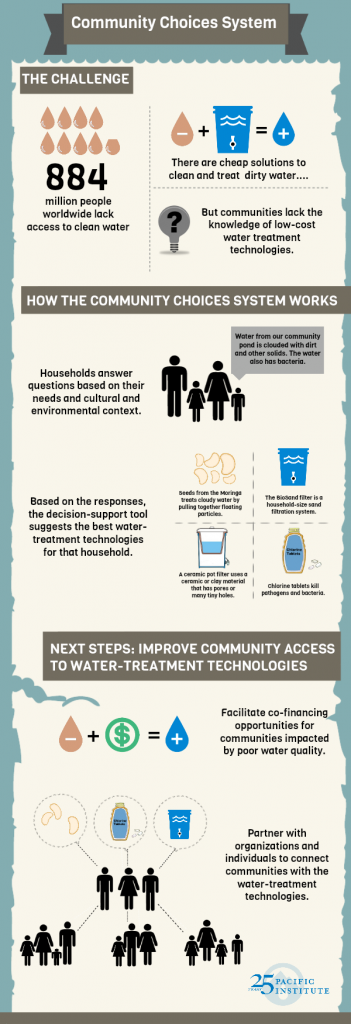By Dr. John Akudago, Senior Research Affiliate
August 13, 2013
A month ago, I blogged on “Improving Access to Water and Sanitation: Is the Answer Individual Behavioral Change?” After several reflections, thoughts on “model journeys and changes we have seen as well as travelled on this road” keep coming to mind. The answer is still not clear. Hence the need to continue to ask, “Where are we on the model journey and what changes have we seen as we travel on these journeys?”
Fresh from college, in the mid-1990s I had the opportunity to be part of a team to develop a participatory model of rural community water and sanitation supply in Ghana. Before the participatory model era, many communities in Ghana, especially in the northern part of the country, had received water supply wells that were financed and managed by the central government. Various types of hand pumps metamorphosed (from monarch, mono, etc. types) in order to reduce the frequent breakdowns and cost of repairs. Changes in hand pumps, however, did not result in any significant increase in communities’ independence, ownership, management, and maintenance of the hand pumps, since they still had to report repair and maintenance issues to a central point which took several days to months before any decision was made as to whether to repair them or not.
As a young graduate with little experience, I thought the participatory process model was a panacea to the problems of water supply management since the concept was to make the communities independent and self-reliant. With that understanding, we zealously took communities through various training workshops and community sessions in order to sensitize them to understand the current water supply reforms and the community’s roles and responsibilities before we started to initiate the change. The process worked well, to some extent, as the communities could now repair their own hand pumps with the introduction of village-level operated and maintained (VLOM) hand pumps. Unfortunately, change in hygiene and sanitation behaviors, and hence reduction in water-related illnesses, were not directly proportional to potable water supply. The question was: what was missing in our community education? The answer was not farfetched; not as much attention was given to sanitation, hygiene, and attitudinal and behavioral change education as was for water supply, hand pump repair, and maintenance.
In order to address the behavioral and attitudinal changes, vigorous sanitation and hygiene campaigns with different models were introduced throughout the country. At first, every new hand pump well in a community attracted the construction of at least seven model community latrines for the entire community. The community latrine was later changed to household latrines because of the difficulty in managing public latrines. These household latrines were highly subsidized with only labor contribution from the individual households, but the objective of the model household latrine technology being accepted and adopted by other households in the communities was not realized. Hence household latrine adoption and use was low, if present at all. The initiative did not seem to yield intended results.

More pragmatic models saw the introduction of participatory hygiene and sanitation transformation (PHAST); community-led total sanitation (CLTS); school WASH; and hand-washing initiatives. Thus, the WASH (Water, Sanitation, and Hygiene) model journey appears to be long and winding with low results. It has been nearly two decades since I began working in the sector, and we still have around 20% sanitation coverage in Sub-Saharan Africa. The biggest question is: “Where have we reached on our model journeys and how much impact have we made? Why are we not seeing the rate of change we expect?” The answer is elusive, but as a WASH professional who has worked in Africa, Asia, and the Caribbean, and was also raised in areas without adequate WASH facilities, I believe that we are not dealing with the issues that can bring the expected changes among our intended targets, as evidenced by the following:
- The failure of communities to let program implementers know that proposed programs would not work in fear of not being given other programs in the future. As such, they are forced to accept them just to please the implementing agencies. Thus, many success stories told by the communities during evaluations are not the true reflection of what occurred on the ground; rather stories were told to please evaluators, implementers, and donors.
- Some implementing agencies were forced to champion unworkable initiatives because the initiatives provided funds that complemented their administrative financial resources. Because of this, many people may not be transparent and forthcoming about unworkable initiatives.
- There are gaps between policies and implementation due to non-functioning institutions which lack human and financial capacities. Most governments are therefore forced to depend on donor funding which normally comes with external conditions, which, when implemented, may yield little or negative results. For example, I recently had a conversation with a renowned development expert in Ghana who intimated that the Community Led Total Sanitation (CLTS) model was not yielding the expected results in Ghana when compared to Bangladesh from where the idea originated. The development expert observed that socio-cultural practices, availability of land and vegetation cover, and lack of human and financial resources to promote the model contributed to low impact. How can families located one kilometer apart be prevented from defecating in the open where no one sees them, and does the model adequately address how to change attitudes where human feces have long been used as food for pigs? Furthermore, cultural and artistic practices and news media that promote and display nudity could mean there is no shame in defecating in the open. Against this background, what is the motivation to own a household toilet?
- In spite of the many WASH models such as PHAST, CLTS, School WASH, sanitation marketing, and information and communication technology (ICT) based tools aimed at promoting behavioral and attitudinal changes, little progress has been made because the models failed to take into account the development contexts. These initiatives were externally driven by professionals who had very little understanding of the socio-cultural, economic, and physical contexts of the people. To what extent have these models influenced culture and beliefs? Behavioral and attitudinal changes are more of an individual issue linked to culture and beliefs, and require a long process and consistent education to influence the individual attitudes and behaviors towards the desired outcomes. What this means is the need for long engagement of individuals, households, and communities as a whole in deliberate communication and education to influence their culture and beliefs that largely impart on their behaviors and attitudes. Attitude and behavior changes are processes and not events, and require quality time for expected results. My concern is whether development agents and donors have the time, resources, and patience to wait for these long-term results.
- Unequal relationships between local implementing agencies and external partners have contributed to low WASH model initiative results. Most external partners need local partners who understand the development contexts better in order to implement pilot programs of the WASH model initiatives like in the case of the Community Choices System (see infographic). However, due to unequal partnerships in terms of financial gains which favor the local partners less, there is less motivation. This not only results in lack of interest in partnership building, but also lack of commitment to work to achieve expected results in the communities and report true scenarios of the test results.
If we are to succeed in providing sustainable access to WASH services worldwide, we need the WASH community to share similar thoughts and reconsider how initiatives can deal with socio-cultural issues influencing the promotion of WASH models. There are already some emerging initiatives that are dealing with community-level change, such as “Everyone Forever” from Water for People. The basic conceptual idea is about working with one community or region to solve its water and sanitation problems forever and for all of the people. With effective implementation of this initiative we can realize the true change we anticipate in the community. I would also recommend that UNICEF, the WASH Cluster Lead, should play a leading role in re-evaluating the existing initiatives and provide feedback for the way forward. This will save donors from their dollars flowing through a long pipe that gets clogged at the tail end.
Pacific Institute Insights is the staff blog of the Pacific Institute, one of the world’s leading nonprofit research groups on sustainable and equitable management of natural resources. For more about what we do, click here. The views and opinions expressed in these blogs are those of the authors and do not necessarily reflect an official policy or position of the Pacific Institute.


